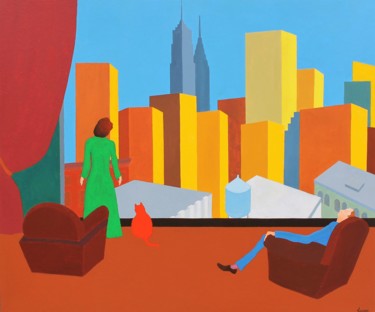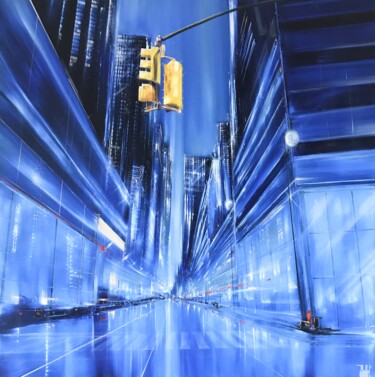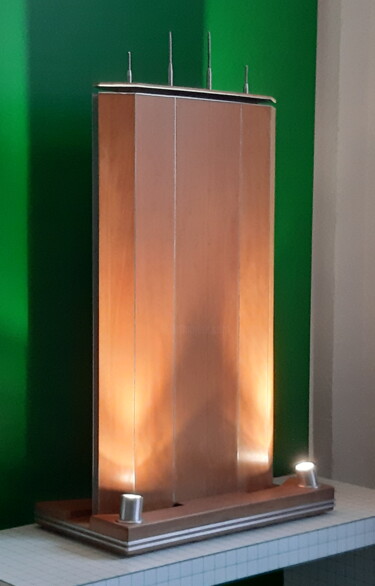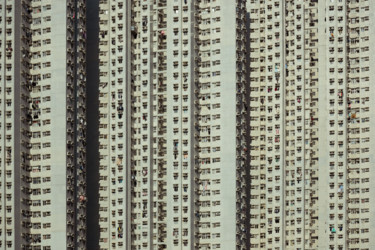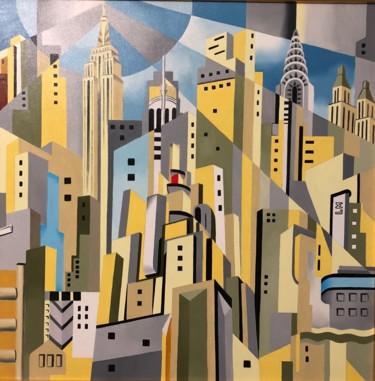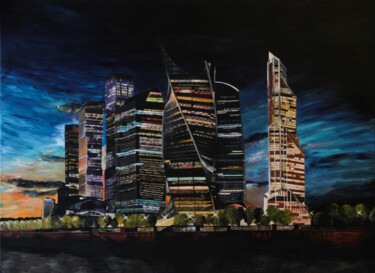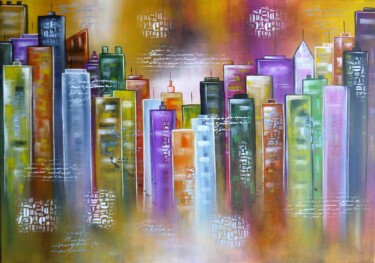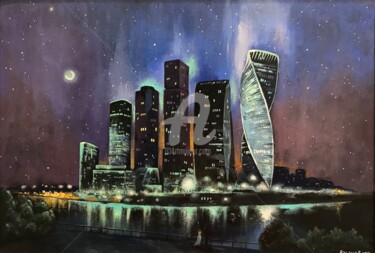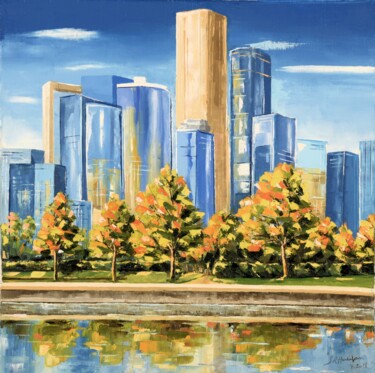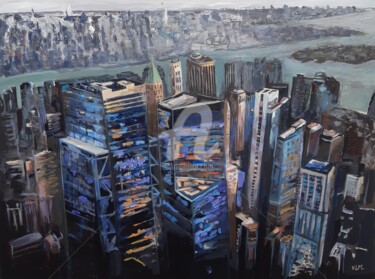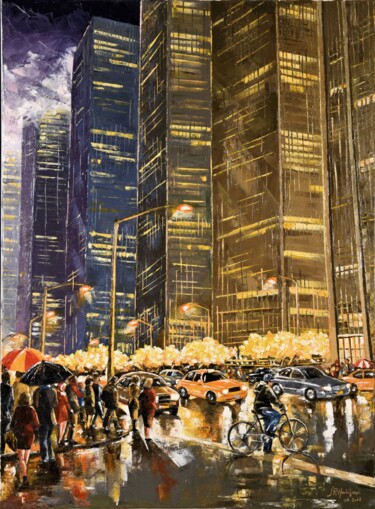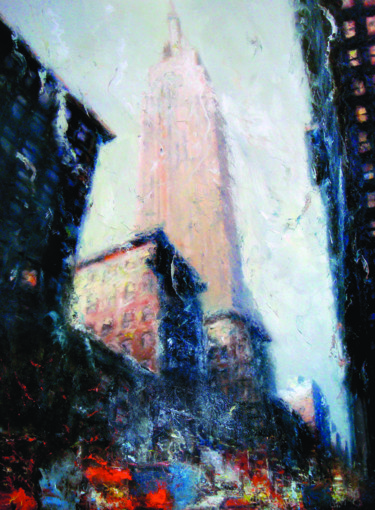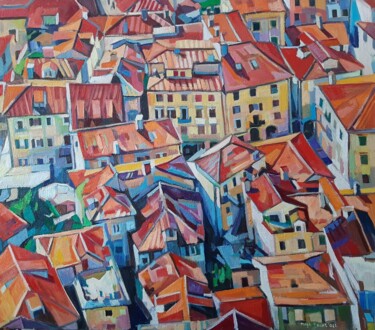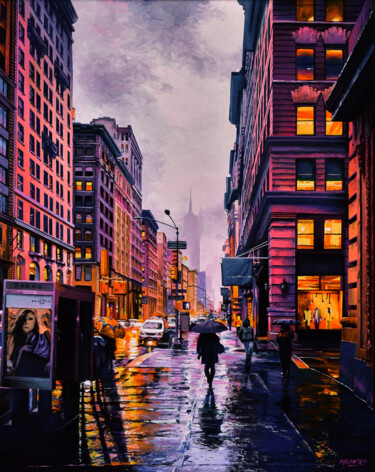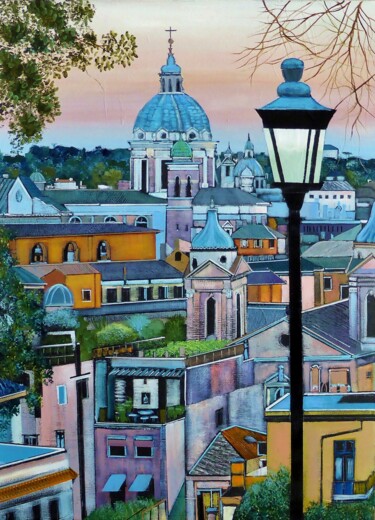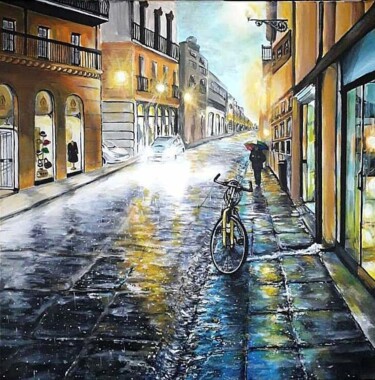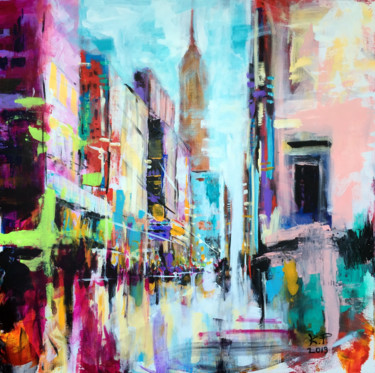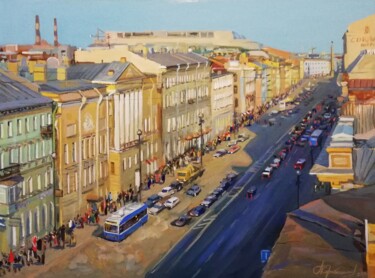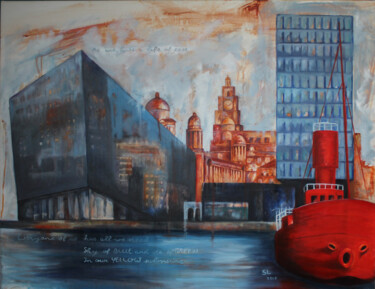 Angela Suto, Enigma, 2021. Oil on wood, 70 x 103 cm.
Angela Suto, Enigma, 2021. Oil on wood, 70 x 103 cm.
Brief history of skyscrapers
The first skyscrapers, namely that type of "tower" buildings in which vertical development and a considerable number of floors is predominant, arose between 1884 and 1939, mainly in the American cities of New York and Chicago. In fact, the first such architecture is considered to be the Home Insurance Building, which, demolished in 1931, was located in the county seat of Cook County (Illinois). That building, which was only ten stories high, represented the beginning of a construction quest to get closer and closer to the sky through a series of architectural and engineering innovations, most certainly including the invention of the first mass production process for steel. The American dream of reaching for the clouds is situated in a historical moment rich in peculiarities; in fact, the first skyscrapers arose as a result of multiple factors, such as: economic growth following the Civil War, the financial organization of American businesses, and the shortage of buildable land. From a practical and technological point of view, the construction of skyscrapers was made possible by two innovations of the 19th century: the elevator and buildings with iron framing, a metal that allowed for walls of normal thickness to be made in height by hanging from the building or resting on it. These features, later innovated and implemented, allowed for the construction of some of the tallest and most iconic buildings on earth, such as, for example: the MetLife Building (246 m), the Woolworth Building (241 m), the Bank of Manhattan Trump Building (283 m), the Chrysler Building (319 m), the Empire State Building (381 m), the One World Trade Center (541 m), the Sears Tower (442 m), the Petronas Towers (452 m), Taipei 101 (508 m) and the Burj Khalifa (828 m), that is the tallest existing building in the world.
 Valérie Le Meur, Crazy New-York, 2019. Acrylic on canvas, 92 x 73 cm.
Valérie Le Meur, Crazy New-York, 2019. Acrylic on canvas, 92 x 73 cm.
 Agus-vaquero, Skyline in New York, 2020. Acrylic on canvas, 39 x 100 cm.
Agus-vaquero, Skyline in New York, 2020. Acrylic on canvas, 39 x 100 cm.
Skyscrapers seen in art
Skyscrapers have totally disrupted, with their height and grandeur, the contours and skies of our cities, offering us, from the heights of their structures, new and peculiar perspectives on the world. It is precisely these peculiarities that have inspired and fascinated twentieth-century artists, who have immortalized the aforementioned buildings in famous paintings and photographs, such as Andy Warhol's Empire (1965), Edward J Steichen's Flatiron (1904), George Bellows' New York (1911), Georgia O'Keeffe's The Radiator Building (1927), Alfred Stieglitz's The City of Ambition (1910), and Marcel Duchamp's The Woolworth Building as a Readymade (1916).
Edward J Steichen, Flatiron, 1904. Gum bichromate over platinum print, 47.8 × 38.4 cm. New York: MET.
George Bellows, New York, 1911. Oil on canvas, 106.7 x 152.4 cm. Washington: National Gallery of Art.
Speaking of Andy Warhol, it is good to highlight how, although the American artist is best known to the masses for his graphic and pictorial work, he was also a screenwriter, film producer, television producer and director. In fact, Empire is a silent film, which, made in black and white, consists of a simple, monotone still shot on the Empire State Building in New York, just as if in a kind of celebration of the iconic American skyscraper. In addition, such a static and untraditional shot, coupled with the lack of characters, highlights the only aesthetic goal of the work: to explore the simple passage of time through the mere observation of a masterpiece of 20th-century architecture. Finally, it is worth noting that, the characteristics of this film are not totally outside of Warhol's graphic production, which is also marked by repeated images. As for George Bellows' New York, on the other hand, such a painting represents a very ambitious work, since having the purpose of immortalizing the whole essence of New York life. In fact, the artist did not want to depict a specific place, but the fusion of different business districts in order to construct a representative image of the city's frenetic pace. Precisely the peculiarities of such realism, represented a great innovation within the traditional urban views of America, surpassing the artistic investigation of other masters of the genre, such as, for example, such as Robert Henri and John Sloan.
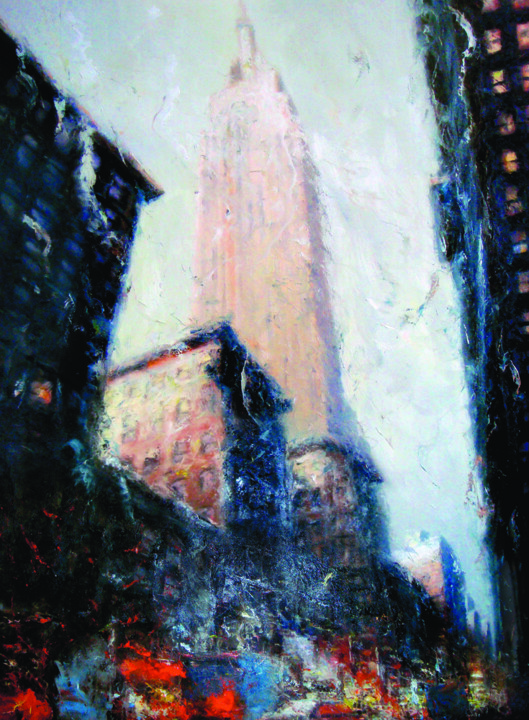 Patrice Larue, The Empire. Oil on canvas, 116 x 89 cm.
Patrice Larue, The Empire. Oil on canvas, 116 x 89 cm.
 Thomas Harutunyan, Empire state building, 2011. Oil on canvas, 65 x 45 cm.
Thomas Harutunyan, Empire state building, 2011. Oil on canvas, 65 x 45 cm.
Skyscrapers in the works of Artmajeur artists
Skyscrapers continue to be a source of inspiration for contemporary art as well, as demonstrated by the production of Artmajeur artists, who with realism, but also irony, flair, originality and innovation have immortalized some of the world's most famous buildings. An example of this is the work of Tony Rubino, Raymond Agostini and Valérie Voinchet, who, through different techniques, styles and points of view, have represented architectural masterpieces suspended between the 20th century and the 2000s.
 Tony Rubino, New York Empire state building banana, 2021. Acrylic / lithograph on canvas, 40.6 x 30.5 cm.
Tony Rubino, New York Empire state building banana, 2021. Acrylic / lithograph on canvas, 40.6 x 30.5 cm.
Tony Rubino: New York Empire state building banana
The Empire State Building represents the symbol of New York City; in fact, this skyscraper, an example of Art Deco modernist design, is located in Midtown Manhattan on Fifth Avenue at 34th Street. This 102-story steel structure, dating from 1931, was the tallest building in the world for about four decades, that is, from the date of its construction until 1970, when it was surpassed by the north tower of the World Trade Center. Despite this, the Empire State Building's popularity remained unchanged as it was also fueled by multiple cinematic masterpieces, such as: Love Affair (1939), An Affair to Remember (1957), Sleepless in Seattle (1993), and the iconic King Kong (1933). It was precisely the latter film that probably inspired Tony Rubino's irreverent mixed media painting, where, of the gorilla, only the banana is left, which, when opened, shows all the majesty, elegance and cultural weight of the American skyscraper. Thus, the Artmajeur artist's work represents an innovative union of the "sacred" and "profane," in which the great architectural and, arguably, cinematic traditions meet with a more popular type of humor.
 Raymond Agostini, Yellow cab, 2018. Acrylic on canvas, 100 x 50 cm.
Raymond Agostini, Yellow cab, 2018. Acrylic on canvas, 100 x 50 cm.
Raymond Agostini: Yellow cab
Raymond Agostini's realist painting looks like a typical contemporary American film shot, which, set in New York City, accurately, and more precisely from the bottom up, captures two iconic subjects of the city: the typical yellow cab and the world-famous Chrysler Building. The latter skyscraper, dating from 1928, only achieved the title of tallest building for 11 months, that is, just before being surpassed by the Empire State Building. Despite this defeat, the uniqueness and beauty of the design of this Art Deco skyscraper, considered by many contemporary architects to be one of the most beautiful buildings in the world, remains undeniable. In fact, in 2005 the Skyscraper Museum in New York asked one hundred architects, builders, critics, engineers, and historians to choose their ten favorite towers in the Big Apple: the Chrysler Building came in first place. In this context, Agostini's realistic and detailed painting perfectly renders the elegance and finesse of execution of the skyscraper, which is depicted in a nighttime setting, illuminated by its own lighted windows.
 Valérie Voinchet, The towers’ players – Burj Khalifa, 2010. Acrylic / oil on linen canvas, 100 x 100 cm.
Valérie Voinchet, The towers’ players – Burj Khalifa, 2010. Acrylic / oil on linen canvas, 100 x 100 cm.
Valérie Voinchet: The towers' players - Burj Khalifa
Imagination, combined with the desire to express one's view of the world, is a key tool in making a work of art unique and innovative. The above is well exemplified by Valérie Voinchet's painting, in which the Burj Khalifa (828 m), or the tallest existing building in the world, has been transformed into a board game. Such a work, as the artist himself explains, becomes a vehicle for multiple allusions, concepts, facts and points of view about the contemporary world. In fact, the two protagonists seated at the table allude to two attitudes related to artistic creation: the afflicted man, which echoes Duchamp's The Chess Players (1911), represents a kind of premonitory sign about the grim mercantile future of art, while the character in front, referred to by Voinchet as the portrait of Damien Hirst, symbolizes questions about the consecration of contemporary creativity. The reproduction of the Burj Khalifa tower, on the other hand, refers to the 2008 financial crash, which ideally decreed the end of an economic ideology that had been in vogue for more than two centuries. Speaking of the child, he, disappointed with his paltry savings, embodies the excessive expenditures put in place for the construction of the Burj Khalifa and, at the same time, the apprehension of 21st-century humans about the importance of money. In conclusion, the concepts expressed by Voinchet's timely and revealing work offer a sincere reflection on the eternal immoderation of man that, perhaps, critical art can remedy.


 Olimpia Gaia Martinelli
Olimpia Gaia Martinelli
